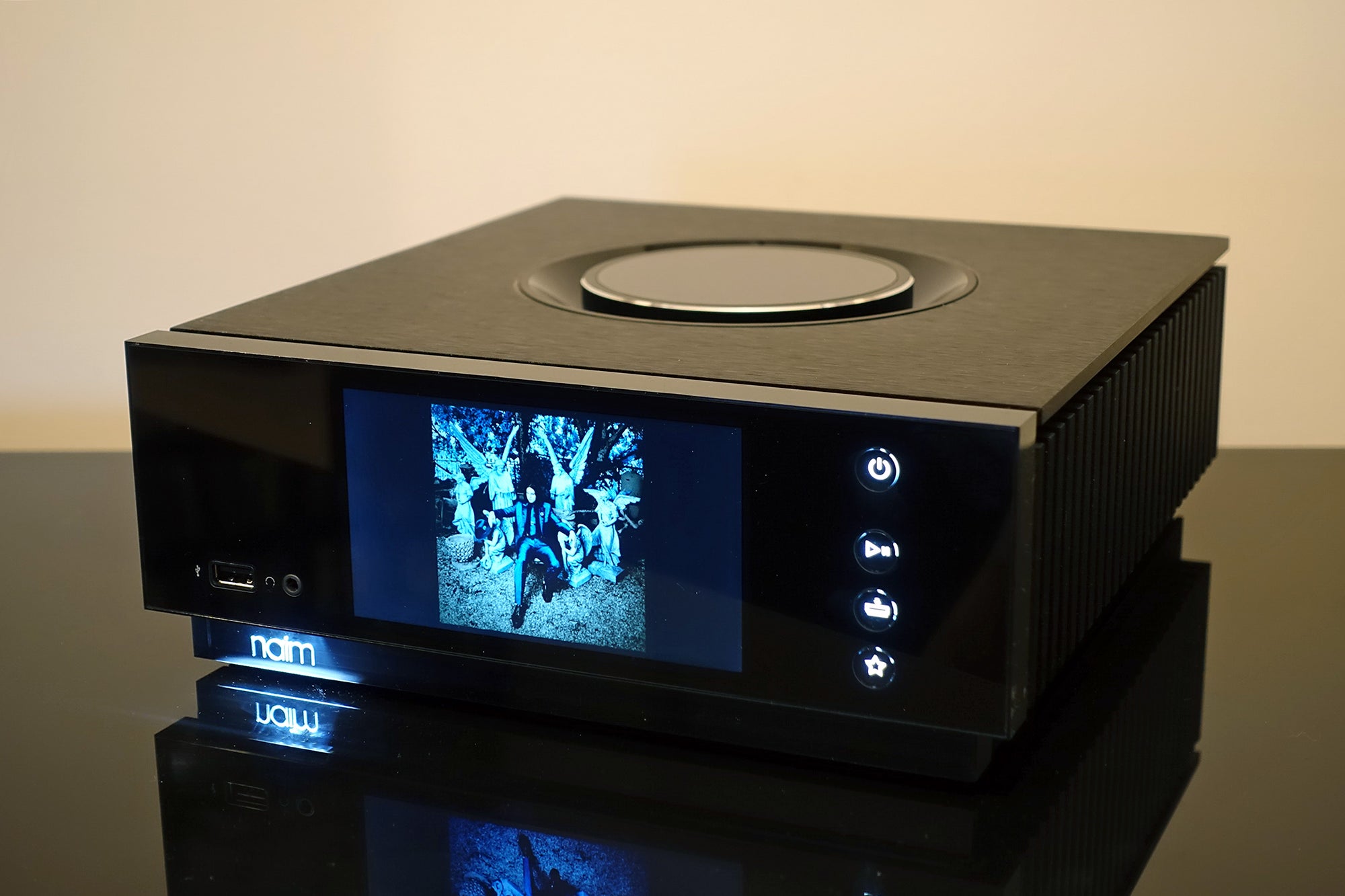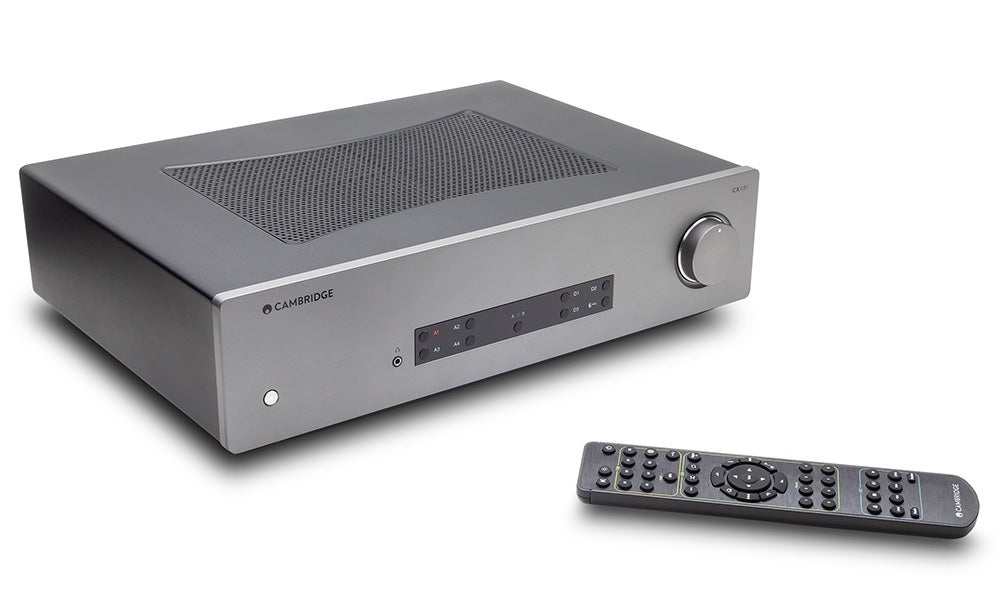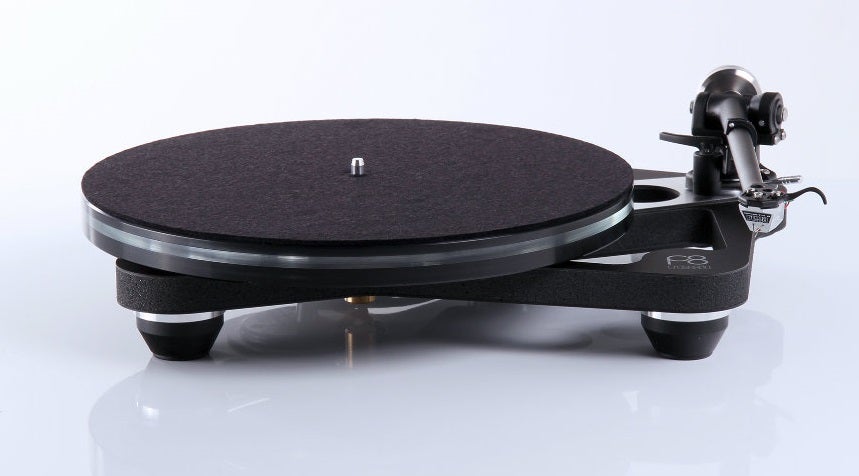Volumio Integro Review
Volumio has wrapped its software in some aluminium and entered the consumer electronics market

Verdict
Volumio has wrapped its software in some aluminium and entered the consumer electronics market, and while some people love a disruptor, in the case of the Integro amplifier, not all disruption is positive.
Pros
- Capable of quite confident, well-organised sound
- Compact and quite decorative
- Extensive specification
Cons
- Doesn’t enjoy complex or dense recordings
- Speaker amplification and headphone amplification sound dissimilar
- Rear panel is a tight squeeze
Key Features
- AppControl app available on iOS and Android
- Roon ReadyRoon Ready device certified by Roon Labs
- Bluetooth aptX Bluetooth streaming
Introduction
Volumio began life building Linux-based software designed for audio playback – those with the confidence and skills can load the Volumio OS onto a PC, Raspberry Pi or similar and build their own music player. The software is free.
Those of us who need the technical stuff done for us, though, can now enjoy an end product: this Integro integrated stereo amplifier with network abilities and a headphone socket. This, of course, means Volumio is setting itself up in opposition to any number of companies who have greater heritage, greater profile and – let’s be honest – greater credibility where this sort of thing is concerned.
Disrupt is a word I dislike in this sort of context, but in this instance there’s no way of avoiding it: Volumio intends to disrupt the market.
Availability
- UKRRP: £1057
- USARRP: $1199
- EuropeRRP: €1199
- CanadaTBC
- AustraliaTBC
The Volumio Integro integrated network amplifier is on sale now, and in the United Kingdom it costs whatever the sterling/euro exchange rate happens to be on that day you order it. It sells for €1199 on Volumio’s own website, and shipping to the UK is free.
It’s a similar deal for Australian customers – so on the day I’m writing this review, UK customers will pay £1057 and Australian customers AU$1952. In the United States it’s definitely $1199, regardless of prevailing economic conditions.
There’s nothing new about the idea of an integrated network amplifier, of course – everyone from Cambridge Audio and Marantz to NAD and Yamaha has one to sell you. From the outset, the Volumio has both price and physical discretion on its side – but it’ll need to perform properly too if it’s going to tempt you…
Design
- 50 x 270 x 150mm (HxWxD)
- 128 x 64 OLED display
- Big fascia controls
Discreet is a word I’ll be relying on here, even more so than the word compact. At just 50 x 270 x 150mm (HxWxD), the Volumio Integro is extremely discreet, very compact and proportioned to be positioned pretty much anywhere you like. It’s not short of competition where functionality is concerned, but as far as dimensions are concerned it’s in a league of its own.
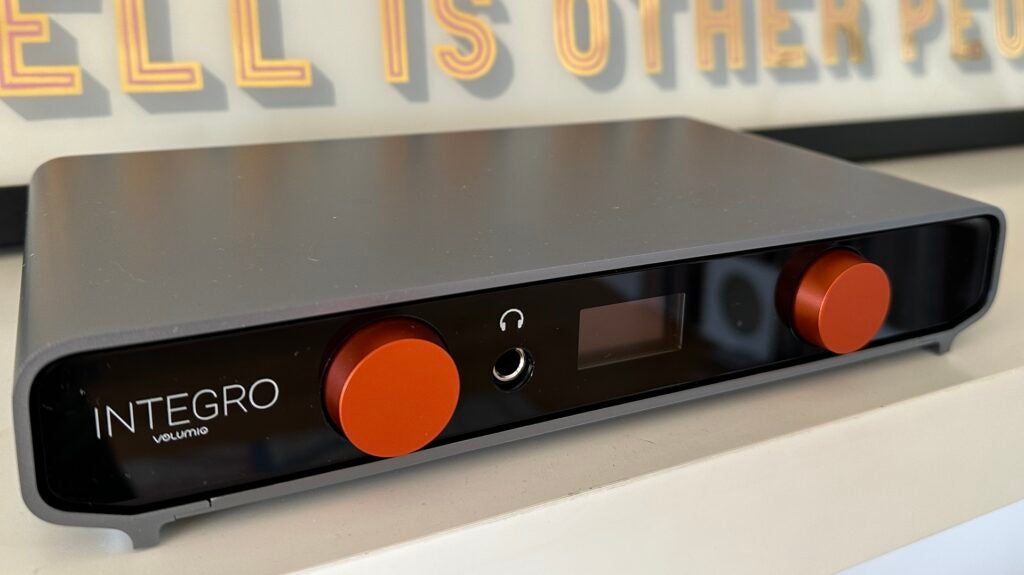
What there is of the Integro is very nicely made of very acceptable materials. The main chassis is of a single slice of folded aluminium with integrated feet, capped with a plastic front face and a metal rear. A pair of oversized and quite assertively orange control dials sit either side of a small, functional OLED display on the fascia, along with a 6.3mm headphone socket – and that’s basically your lot.
Everything is put together perfectly well, and everything feels ready to survive even quite careless ownership. As far as design goes Volumio certainly seems to think less is more – and I reckon there will be quite a few prospective customers who agree.
Features
- 50 Class D watts per channel
- 24bit/192kHz native resolution
- Bluetooth 5.0 with aptX Low Latency
The downside of being compact and discreet in physical terms is that it can be tricky to squeeze in all the physical connectivity you wish to include. So while the front of the Integro is calm and minimal, the rear is hectic. There’s an awful lot going on back there.
At either end of the panel are a pair of chunky speaker binding posts, able to accept either bare wire or 4mm banana plugs. Then, reading from left to right, you’ll find: a USB 3.0 slot (for high-speed drives); an Ethernet port (for complete network stability); an HDMI socket (more on that later); a microSD slot (for expanding unit memory or adding music files); a USB-C slot (for servicing and updates); a USB 2.0 slot (for thumb drives, keyboards, mice and so on); a digital coaxial and a digital optical input (both able to deal with file sizes up to 24-bit/192kHz); line-level stereo RCA inputs (for whatever you fancy); a pre-out for a subwoofer; a socket for mains power.
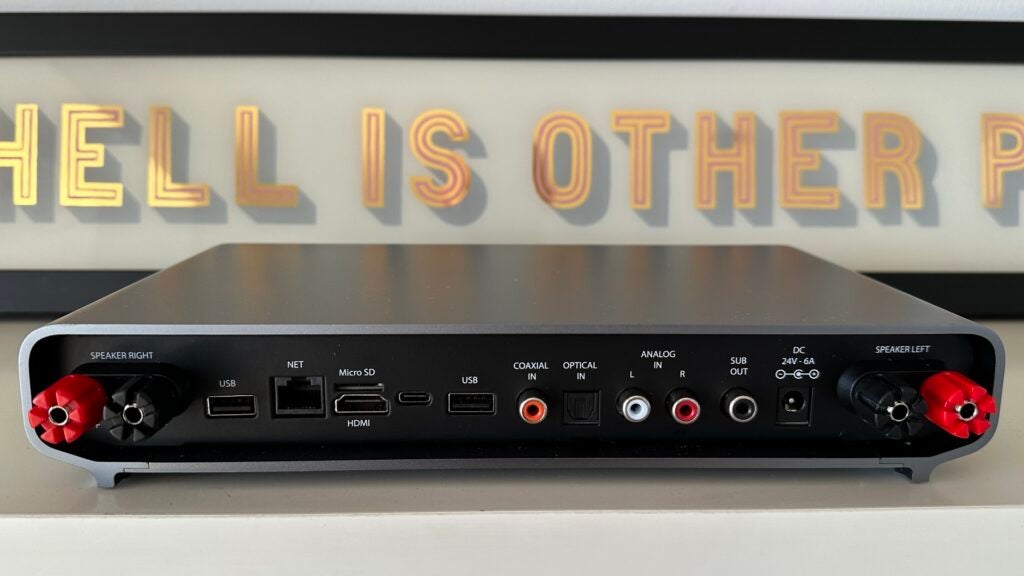
It follows that there’s next-to-no space between them, so you won’t be able to use those big, chunky (and expensive) interconnects you saved up for. Wireless connectivity is taken care of by dual-band Wi-Fi and by Bluetooth 5.0 with aptX Low Latency codec compatibility.
The HDMI socket, rather gallingly, is an output – you can connect it to a display of up to 4K resolution. Volumio suggests it’s good as an alternative to the little screen of your mobile device when it comes to controlling the Integro, but given that it either requires connection to a touchscreen device or that a mouse/keyboard is connected via USB it’s not quite as handy as it may at first appear. And anyway, I’m sure I’m not the only one who would prefer it to be an input, so my TV could feel some Integro benefit.
On the inside, Volumio uses Khadas, Infineon and Texas Instruments componentry to do the audio business. The speaker amplification circuitry is separate from the headphone amplification equivalent – and, as becomes clear pretty quickly, there are more differences between them than simple physical separation.

Control is available by using the two big turn/push controls on the fascia, or via the Volumio control app. The fascia dial on the left takes care of power on/off and input selection, while the dial on the right handles volume up/down and mute – the display between them gives a numerical indication of volume or a graphic representation of the selected input.
The control app, meanwhile, is a fair bit more comprehensive – it has quite a lot of tweaky options around audio buffering, one-click volume steps, Roon playback options, plugin installation and so on. It’s where you can integrate your Qobuz and TIDAL accounts, check for updates and do the more usual control app stuff. It’s reasonably stable, reasonably responsive and reasonably easy to navigate – which puts it well ahead of quite a few alternatives I could mention.
Sound Quality
- Neutral, positive sound through speakers
- Lean, almost chilly sound through headphones
- Flustered by complicated or more intense recordings
It may sound a bit odd to suggest the way the Volumio Integro sounds is a game of three halves, but bear with me. I am confident I can make a case for saying so.
The first half concerns the way the Integro performs when given some fairly straightforward content to deal with – and that’s from any wired or wireless source. A vinyl copy of Max Romeo’s War Ina Babylon, a CD of Nick Cave & The Bad Seeds’ Push the Sky Away or a 24-bit/88.2kHz file of Anna Meredith’s Unfurl via Roon… it’s all the same to the Integro.
It establishes a nicely neutral overall tonality, digs respectably deep into the frequency range and controls low frequencies well. Midrange fidelity is similarly impressive, and though the soundstage the Integro creates is far from the biggest it’s fairly well defined – so vocalists get a bit of breathing space. The top end has bite and crunch, although it sounds mildly rolled off and doesn’t reach as high as it might.

Rhythmic positivity is convincing, and there’s enough dynamic headroom available to give the differences between the more contemplative moments and the grandstand finish in a recording good expression. Detail levels are acceptably high, even if the Volumio lets some transient stuff escape, and the integration of all areas of the frequency range is achieved confidently.
Change up to something a little more complex, though – Lambchop’s So, I Hear You’re Moving or Gershwin’s Rhapsody in Blue, for instance – and the Integro gets a little anxious. The soundstage gets slightly muddled, its definition deserting it somewhat. The ability to identify and present the more minor details in a recording goes astray.
And the across-the-board harmonic variations the amp happily identifies when the pressure’s off may as well not be present at all in a recording of increased intricacy. This is what constitutes the second half of the Volumio’s performance.
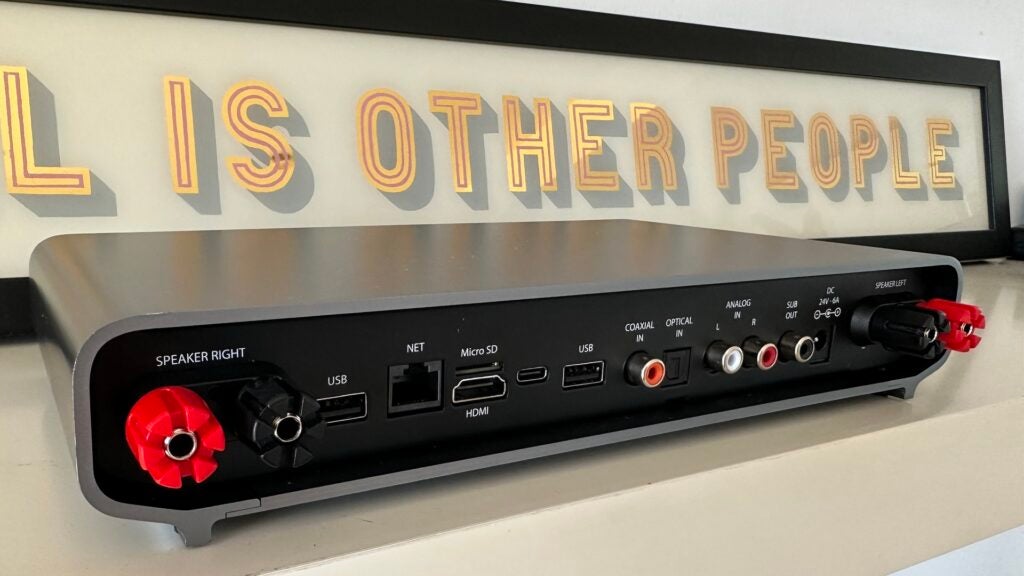
So yes, the third half: that’s the way the headphone output sounds. Headphones sound different to speakers, of course – but there are obvious tonal differences between the way the Integro presents music through its speaker amplification and through its headphone amplification.
The neutrality of the speaker sound is replaced by a thinner, less substantial alternative – the aural equivalent of the ‘cool’ setting on your TV menus. It’s not necessarily worse, but it is distinct – and that in itself is a pretty unusual state of affairs. And the fact the headphone output seems better able to retain and reveal the detail in a complicated recording the speaker output can’t only adds to the sense that these are two individual amplifiers somehow squeezed into a cabinet that’s really not even big enough for one of them.
Latest deals
Should you buy it?
You know that small is beautiful: When you consider the amount of functionality available here, the Integro is impressively compact and discreet
You enjoy music of all styles and complexities: The Integro isn’t all that comfortable dealing with complicated or dense recordings. Not through its loudspeaker amplification, anyway…
Final Thoughts
I’m all for challenging the established order, trying something just a little bit different, or even just doing what everyone else is doing but charging less for it.
Difference for difference’s sake is a bit more of a stretch, though – and more affordable is only better value if the more affordable option is definitely worth having. The Volumio Integro is part of the way to being what it thinks it is – and in truth I’m already quite excited to see what version two might be like…
How we test
We test every amplifier we review thoroughly over an extended period of time. We use industry standard tests to compare features properly. We’ll always tell you what we find. We never, ever, accept money to review a product.
Find out more about how we test in our ethics policy.
Tested for more than a week
Tested with real world use
FAQs
Yes, the Integro can be connected to another display but its HDMI output can only output signals rather than receive them.
Full specs
Sustainability
Trusted Reviews’ holds the fact that global warming is not a myth as a core value and will continuously endeavour to help protect our planet from harm in its business practices.
As part of this mission, whenever we review a product we send the company a series of questions to help us gauge and make transparent the impact the device has on the environment.
We currently haven’t received answers to the questions on this product, but will update this page the moment we do. You can see a detailed breakdown of the questions we ask and why in our sustainability info page.

